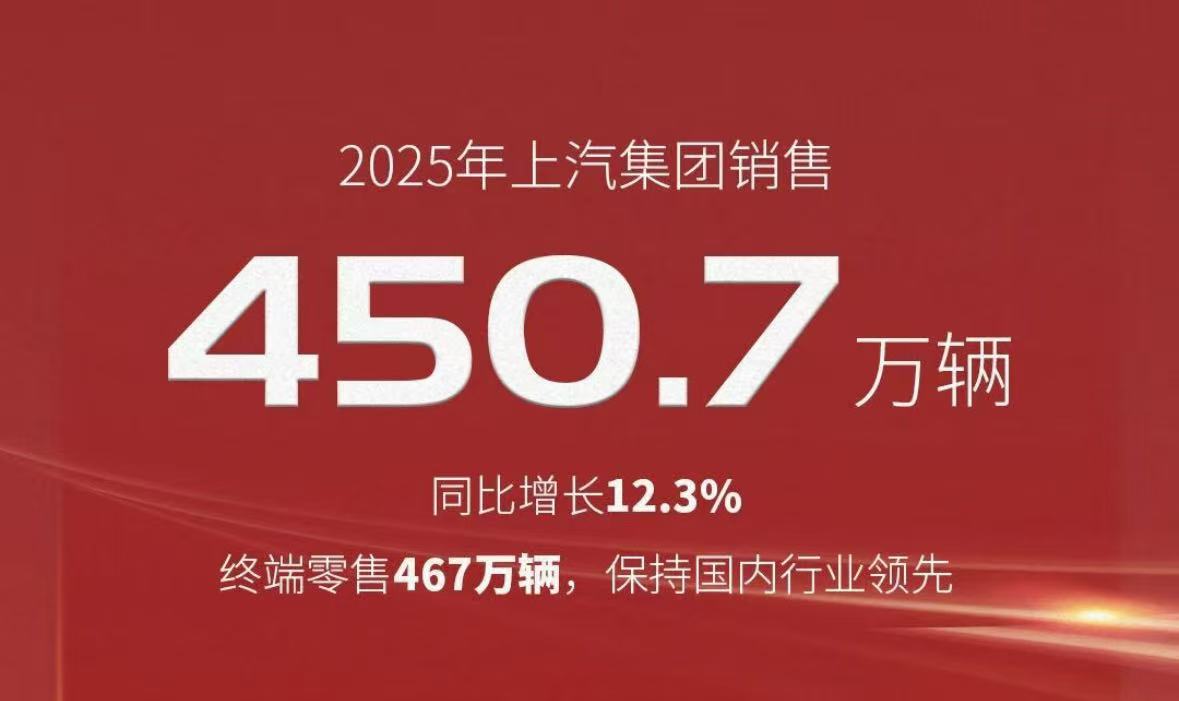Gasgoo.com (Shanghai) - As environmental and energy problems continue to increase worldwide, it is becoming ever more evident that automobiles, with their high rates of fuel consumption and carbon dioxide emissions, are in need of a major reform. Developing new energy vehicle technology has become a major focus of the global automobile industry. China is one of the world's seven major centers of development for this new technology. The government has done its part in implementing new policies to improve knowledge and further development of this new industry. However, due to a variety of factors, China still lags behind other major automotive markets when it comes to this new breed of technology.
I. Background
In pace with economic development, automobile sales in China have also experienced rapid growth. In 2009, China became the world's largest manufacturer and buyer of automobiles. Four years later in 2013, Chinese automobile sales broke the 20 million barrier, with total annual sales reaching 21.98 million units. At the end of that year, there were a total of 250 million motorized vehicles on Chinese roads, with 137 million of those being automobiles.
As the number of automobiles in the country increased, so too has the amount of fuel consumed and oil imported. According to the country's latest Five-Year Development Guideline, China should keep its foreign oil dependency under 61 percent by 2015. However, as of now that rate is still dangerously close to that rate. Statistics show that Chinese dependency on foreign oil broke the 50 percent mark as early as 2009, and quickly increased to 58.1 percent four years later.
In addition to the energy crisis, the growing number of automobiles is also leading to increasingly dangerous amounts of emissions. Both last year and this year, large parts of the country continued to suffer from swathes of smog that have led to increasingly dangerous pollution levels. How to control and decrease carbon emissions is a major question for the country's future development.
Energy vehicles are a major focal point of development. In response, the government has released a series of policies aimed at supporting and fostering development. As seen in the table below, the government offers subsidies of up to 60,000 yuan for pure electrics and up to 35,000 yuan for plug-in hybrids.
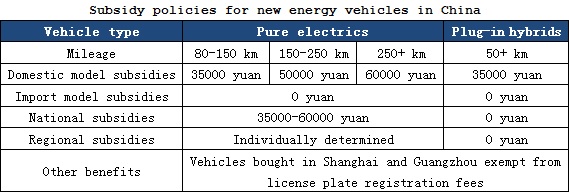
Additionally, the government has issued the following specific targets for new energy vehicle development in the country: by 2015, cumulative production and sales volumes for pure electrics and hybrids should reach 500,000 units combined, while by 2020, that figure should reach five million units.
II. Present situation
Despite all of this negative information, there are still quite a few factors favorable to the domestic growth of new energy vehicles. That said, the Chinese market still lags behind other markets overseas. New energy vehicle sales were barely above 10,000 units in 2012. The following year 17,600 new energy vehicles were sold in the country, with the majority of those sales, 14,600 units, being of pure electrics. With those figures, it will be difficult for the country to achieve its goal of 500,000 cumulative new energy vehicle capacity by 2015.
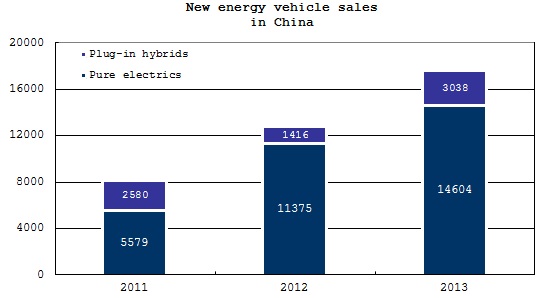
By comparison, new energy vehicle sales in the US are much higher. In 2013, combined sales of hybrids and pure electrics totaled 96,000 units. The Tesla alone managing to achieve an annual sales volume of 18,700 units, exceeding the total number of new energy vehicles sold in China over the whole of course of the year.
Chinese new energy vehicle sales over the past few years have primarily relied on the release of new models, whereas new energy versions of currently available models have been relatively low. Thanks to the government's strong support for the new technology, several manufacturers have taken their hand at releasing new models the new energy vehicle field. There are over ten domestically manufactured new energy vehicles in the Ministry of Industry and Information Technology's latest list, from manufacturers such as Chery, BYD, BAIC, SAIC, Nissan's Venucia and Chevrolet. The list below details the major models available in the country.
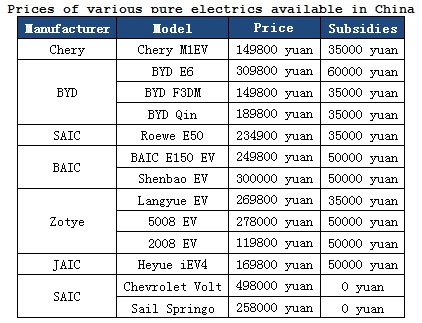
As of now, models with officially released Chinese sales figures include the Chery M1 EV, BYD F3DM, BYD E6, BAIC E150EV, BAIC Shenbao EV, Zotye Langyue EV, Chevrolet Volt and GM Sail EV. None of these models have managed to achieve sales of over 2,000 units. BYD posted the strongest results, with sales of its E6 and F3DM totaling 1,544 units and 1,005 units, respectively.

Meanwhile, in the US, the Chevrolet Volt led the 2013 sales charts, followed by the Nissan Leaf, Tesla Model S, Toyota Prius plug-in hybrid, Ford C-Max Energi plug-in hybrid, Ford Fusion Energi plug-in hybrid, Ford Focus EV, Toyota RAV4 EV, Mitsubishi i and Smart forTwo EV. Worth noting is that the six latter entries each achieved sales of over 6,000 units.
Although there is a definite discrepancy between domestically manufactured new energy vehicles and their overseas offerings, the gap is not very big. The following table compares a selection of pure electric models available either in domestic or overseas markets: the Tesla, GM's Sail Springo, BYD's E6, SAIC's Roewe E50 and BAIC's E150 EV. Being a luxury vehicle, the Tesla boasts especially strong specifications. However, the Chinese models still manage to meet strict requirements when it comes to total mileage and safety features. The differences between the Springo and the Chinese models when it comes to battery quality, charging times and aftersales service are fairly minor.
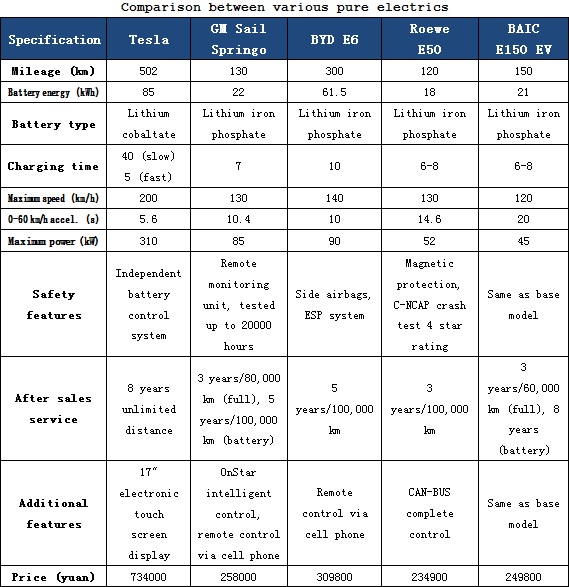
III. Issues
There are clearly some major issues that have hindered the development of new energy vehicles in China.
Firstly, the construction of the necessary infrastructure for new energy vehicles, such as charging stations and battery exchange points, has been relatively slow and incomplete. Although the government and manufacturers have worked hard to encourage new energy vehicle development, the unequal distribution of and differing standards between basic infrastructure, such as charging stations and charging posts, has made it difficult for manufacturers to conduct proper R&D, production and sales work.
Secondly, retail prices for new energy vehicles remain relatively high. Despite continuing advancements in technology and falling production costs, as well as government support in the form of appropriate subsidies, new energy vehicles are still not a viable choice for many consumers. For example, even with a 70,000 yuan subsidy if purchased in Shenzhen, the BYD Qin's price tag of 119,800 yuan is still much higher than the more affordable BYD F3.
Finally, there is lack of knowledge on the part of consumers when it comes to new energy vehicles. Domestic consumers don't know much about electric vehicles outside of their existence. Many consumers are still skeptical of the safety and control of new energy vehicles, even though such concerns have already been proven unfounded. As such, there is a major need for boosting consumer awareness.
As energy and environmental concerns continue to grow daily, new energy vehicles remain an important focal point for future development. The government has done its part in introducing legislation to create a suitable environment for development of these vehicles, while domestic manufacturers are releasing products whose quality is close to their international rivals. As such, the future of the technology lies in how all parties deal with the obstacles hindering its development.







